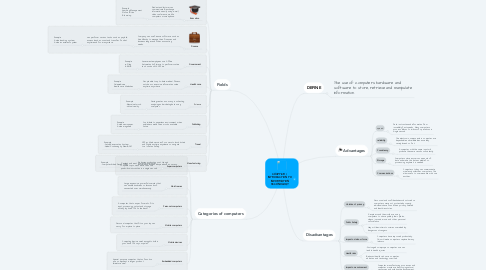
1. Fields
1.1. Education
1.1.1. Student and lecturer can communicate & exchange information easily using e-mail, video conference, mobile computers or smartphone.
1.1.1.1. Example -Learning Management -Online Tuition -E-learning
1.2. Finance
1.2.1. Company can use finance software such as QuickBooks to manage their finances and business ledger and other accounting needs.
1.2.1.1. can perform various tasks such as pay bills, access bank account and transfer fund at anytime and from anywhere.
1.2.1.1.1. Example -Online banking system -Online Investment system
1.3. Government
1.3.1. Goverment employees use Office Automation Software to perform routine task such as MS Office.
1.3.1.1. Example -e-Filing -HRMIS
1.4. Health care
1.4.1. People able to up-to-date medical, fitness, nutrition or exercise information online anytime, anywhere.
1.4.1.1. Example -Telemedicine -Health care Websites
1.5. Science
1.5.1. Peole greater accuracy in collecting, analyzing and modeling data using computer.
1.5.1.1. Example -Neural network -Virtual reality
1.6. Publishing
1.6.1. Contribute to paperless environment when publishers make their works available online.
1.6.1.1. Example -Online newspaper -Online magazine
1.7. Travel
1.7.1. Offer Web services for users to book hotels and flights anytime anywhere or navigate to a location safely.
1.7.1.1. Example -Online Reservation System -Global Positioning System(GPS)
1.8. Manufacturing
1.8.1. Reduces production cost though automation, increased speed and accuracy.
1.8.1.1. Example -Computer-Aided Design (CAD)
2. Categories of computers
2.1. Supercomputers
2.1.1. Fastest and most powerful computer. Capable to process more than one quadrillion instruction in a single second.
2.2. Mainframes
2.2.1. Large, expensive, powerful comuter that can handle hundreds or thousands of cannected user simultaneously.
2.3. Personal computers
2.3.1. A computer that can perform all of its input, processing, output and storage activity by itself (fit on the desk)
2.4. Mobile computers
2.4.1. Personal computer that fit on your lap can carry from place to place.
2.5. Mobile devices
2.5.1. Computing device small enough to hold in your hand (fit on your palm).
2.6. Embedded computers
2.6.1. Special purpose computer that us function as a component in larger product (miniature size).
3. DEFINE
3.1. The use of computers hardware and software to store, retrieve and manipulate information.
4. Advantages
4.1. speed
4.1.1. Data, instructionand information flow incredibly fast speeds. Many computers process billions or trillions of operations in single second.
4.2. reliability
4.2.1. The electronic components in computer are dependable and reliable because they rarely break or fail.
4.3. Consistency
4.3.1. A computer with the same input will produce the same results consistently.
4.4. Storage
4.4.1. Computers store enormous amounts of data and make this data available for processing anytime it is needed.
4.5. Communications
4.5.1. Computers today can communicate wirelessly withother computers. This allow users to communicate with one another.
5. Disadvantages
5.1. Violation of privacy
5.1.1. Percsonal and confidentialrecords stored on computers were not protected properly, individuals have found their privacy violated and identities stolen.
5.2. Public Safety
5.2.1. -People around the world are using computers to share publicly their photos, videos, journals, music and other personal onformation
5.2.2. they will be victims to crimes commited by dangerous strangers.
5.3. Impact on labour force
5.3.1. Computers have improved productivity. This will make computers replaced many labours.
5.4. Health risks
5.4.1. -Prolonged or improper computer use can lead to health injuries
5.4.2. Behavirol health risks are computer addiction and technology overload.
5.5. Impact on environment
5.5.1. Computer manufacturing processes and computer waste are destroying natural resources and polluting the environment.
